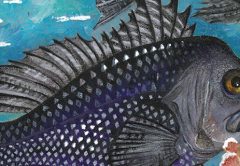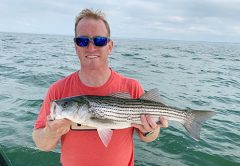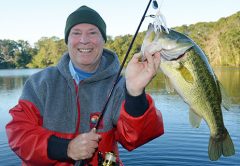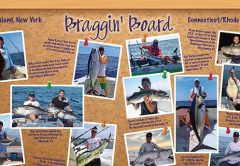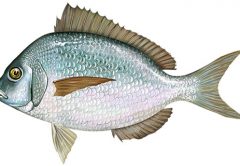J une is the month when fluke season really begins in our Ocean State. While the commercial guys have been bringing in fluke since May, and a few recreational anglers got lucky, “fluking” really heats up now. Add the fishapalooza “Fluke ‘Til Ya Puke,” hosted by Big Game Fishing in and Snug Harbor’s 7th annual Doormat Derby in Wakefield, and we are on the verge of calling Fluke Rhode Island’s official state fish!
As many of you know, fluke–along with flounder, sole, turbot and halibut–are all flatfish; they not only appear truly flat, rather than the rounder full-bellied fish, but they also have two eyes on one side of the head. Fluke are often confused with flounder, but there are real differences. The most obvious is that the flukes’ eyes are on the left side of the head and they have larger mouths with more prominent teeth than flounder. And to really confuse the issue, fluke are often called “summer flounder” whereas “winter flounder,” such as dab, sole and lemon sole, have both eyes on the right side…but the real difference is in the taste!
Generally, fluke are larger than flounder, which makes their meat, when cooked, more firm and meaty than the more delicate texture and taste of the smaller flounder. Very big fluke are sometimes called “doormats” because of their size and shape. These “mats” are similar to Atlantic halibut, often served as a “beefy” steak, whereas the smaller fluke can be a bit more like flounder and sole in taste, often prepared simply with lemon, butter or wine. Larger fluke holds up better to grilling than the flakier flounder, but smaller fluke are just as delicious lightly breaded and pan-fried with a traditional meuniere or amandine sauce. And who better to give us a fantastic fluke recipe than Chef Kevin King of none other than Fluke Wine Bar & Kitchen of Newport?
“With the natural arrival of summer flounder in Rhode Island waters and its predominance in late May and June, fluke makes a great summer special,” says Chef Kevin. “And that’s no fluke! Given the name of the restaurant, we almost always have some sort of fresh flatfish on the menu, maybe a lemon sole or dab (winter flounder) in the fall and certainly our beloved RI fluke in the summer.”
In the fall, fluke head out to off-shore waters and the sole and dab come inland, which is why they are sometimes called “winter flounder.” But winter flounder are not predators the way summer flounder are. Fluke are bottom-dwellers, changing the color patterns of their skin, chameleon-like, to blend in with their surroundings. They can hide for hours buried at the sandy and muddy bottoms of harbors, bays and along the open coast, with only their heads exposed, ready to pounce on their prey…so bring lots of hooks and sinkers when fishing for fluke! Aggressive predators, they feed on shrimp, mollusks and other crustaceans, as well as smaller fish, swimming short distances at high speeds, even sometimes jumping to the surface to chase their prey, unlike the docile winter flounder that remain mostly buried, almost stationary, biting off clam siphons that protrude from the sand.
Our Coastal Angler Rhode Island Magazine editor Zach Harvey, aka Master of the Fish-geist, advises using strips of squid as the best bait to land the keepers–the big fluke. He spends a lot of time thinking about the how, where and when of landing these tasty doormats. Check out his stories in our May and June issues for a deep dive into the tecniques and secrets of successful flaking.
“Yet, no matter how robust the data and sophisticated the calculations used to derive the resulting population estimates, there is inevitably some degree of error, or uncertainty, which must be buffered against,” cautions David Newman of the Natural Resource Defense Council’s Oceans Program. He goes on to explain in his blog, Learning from Summer Flounder’s Successful Recovery, “With every bit of good news, such as a survey indicating an abundant ‘year class’ of juvenile fish, fisheries managers have set (summer flounder) catch limits close to the line of the projected population, only to have to cut catch when new information shows the population is not growing quite as quickly as thought.” Fortunately or unfortunately, depending on how you see it, laws requiring precautionary buffers are being implemented now to make fluke and flounder fishing more predictable and sustainable throughout the year.
For a beautiful and delicious preparation, try this tasty summer recipe from RI’s Chef Kevin King at Fluke Wine Bar and Kitchen in Newport:
[colored_box color=”blue”]
Fluke with Charred Yellow Tomato Vinaigrette served with Ratatouille and Cous Cous
Recipe by, Chef Kevin King
Ingredients:
(2 6-7oz Fluke Filets)
Vinaigrette
• 2 medium Heirloom Yellow Tomatoes 1 Shallot
•2 cloves Garlic
•3⁄4 C Meyer Lemon Juice
•1⁄4 C Red Wine Vinegar
•1⁄2 C Extra Virgin Olive Oil
Cous Cous
•1 package Cous Cous – follow directions on package for preparation
Ratatouille
each vegetable to be prepped to the same size – medium dice
•1 Japanese Eggplant
•1 Zucchini
•1 Yellow Squash
•1 cup Fava Beans
•Olive Oil or Butter
•2 oz Red Tomato Sauce
•1 oz Fresh Basil – chiffonade
Instructions:
1.Char tomatoes on broiler or grill. Once cooled, add all ingredients except olive oil to blender and puree till smooth. Very slowly add 1⁄2 cup Extra Virgin Olive Oil. Set aside.
2.Once vegetables are prepared, sautee all together in olive oil or butter until tender. Add 2 oz Red Tomato Sauce and 1 oz of Basil. Set aside
3.Pan Sear Flounder – 2 minutes each side or until desired doneness.
4.To serve, place ratatouille on one side of plate, cous cous on another side of the plate and charred yellow tomato vinaigrette in a pool to the side. Place fish on top of the three components. Enjoy.
[/colored_box]





